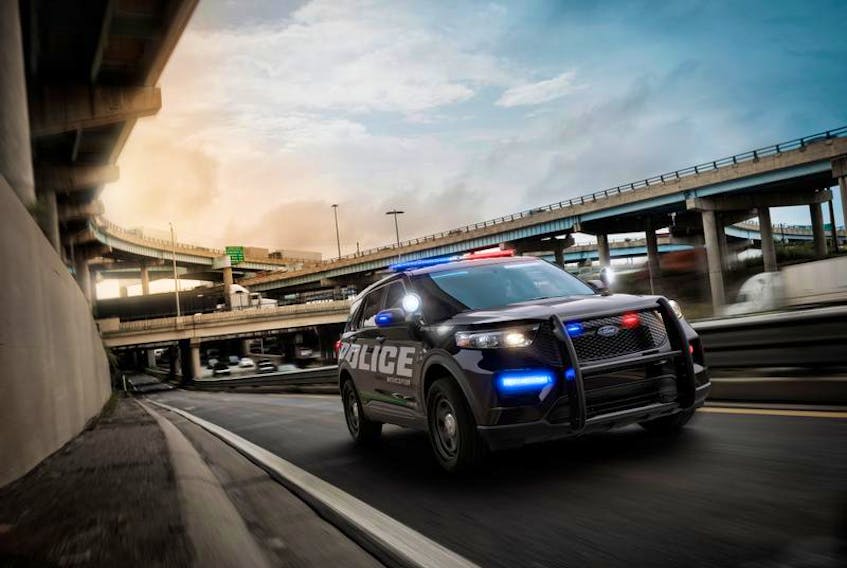Ford Motor Company has been in the business of building police cars for almost seven decades. In 1950, they were the first manufacturer to offer a specific upgrade package to a production car that addressed the safety, performance and reliability required to meet policing needs.
A year later, the “Interceptor” nameplate was introduced on models with the optional 110-horsepower flathead V8 engine and the moniker has been used on Ford police vehicles ever since.
Police Interceptors were everywhere. By 1961, 58 per cent of police vehicles patrolling the 50 largest U.S. cities were Ford products.
While the acceleration, braking and cornering of police cars improved through the 1960s, my high school dream was to buy a retired 1963 Ford Galaxie Interceptor. The ones used by RCMP in southern New Brunswick were two-door post sedans propelled by pursuit-rated 330-horsepower 390 V-8 engines. With three-speed manual transmissions and three-in-the-tree shifters, they were fast in their day.
A local legend, Neville Gorley, had purchased a used one when the RCMP retired it. With racing slicks on the back and exhaust headers, Neville won his class most weekends at the local drag strip. I can still see the front wheels almost popping off the ground as he slammed the column shifter up into second gear. Everyone knew it was an ex-RCMP cruiser so the car’s bad-boy reputation at the drag strip was probably a deterrent for would-be speeders.
In 1982, the California Highway Patrol was looking for a lightweight, high-speed police car. Foxbody 5.0-litre Mustangs were in production at the time and Ford modified them to suit the needs of law enforcement.
Over the next 21 years more than 15,000 of them were built and patrolled millions of miles of American highways. I recall a Mustang advertisement of the day featuring a Police Interceptor model. The tag line was “This Mustang Chases Porsches for a Living.”
In 1983, Ford introduced a Police Interceptor variant of the Crown Victoria with upgraded brakes, suspension and a 5.8-litre high-output V8. These full-sized cars were the backbone of policing in Canada and the U.S. until discontinued in 2011. Some still roam the landscape as taxicabs and tough-as-nails, fuel-thirsty family sedans.
Ford’s Police Interceptors have continued to support law enforcement fleets. The name itself seems enough to keep drivers in line and by 2017 Ford had 74 per cent of the police car market in Canada.
The line-up is lead by the Police Interceptor Utility, based on a Ford Explorer. The 2020 model that might pull you over later this year will be doing all the right stuff.
While the officer outside your vehicle is dealing with the situation at hand, the cruiser will be dutifully parked behind at the right angle, front wheels cranked so it misses the officer if someone clobbers it from behind.
Emergency roof lights will be flashing to alert drivers to slow up because someone is not having a good day. The radios may be buzzing with chatter, a video camera will be recording out the front windshield and the headlights will be on.
One thing the police vehicle will probably not be doing, however, is idling its engine because it will be a hybrid, a power system police forces around the world are beginning to incorporate into their patrol vehicles.
Hybrid technology makes sense in patrol vehicles. Policing requires a lot of stop and go driving that is best for keeping the lithium-ion batteries charged. This stored charge is what powers the electrics during extended stops rather than an alternator spun by an idling gasoline-powered engine.
This means reduced fuel consumption, lower CO2 emissions and big fuel cost savings for police forces, and in turn taxpayers. One study suggests up to $5,900 per vehicle per year.
All 2020 Police Interceptor Utility vehicles will be purpose-built hybrids with modifications engineered around placement of its lithium-ion battery. By keeping the centre of gravity low, designers haven’t intruded on cargo or passenger space. Improved cooling, upgraded wheels and tires and specially tuned brakes come together in a competent, upgraded Ford Explorer not to be messed with.
They are fast and agile too, so behave out there. Michigan State Police tested the all-new 318 horsepower AWD Police Interceptor Utility and it had the fastest 0-160 km/h acceleration, fastest lap, fastest average lap and highest top speed of 220 km/h, versus competitive police utility vehicles tested, including V8 entries.
Inside, heavy-duty cloth front seats with reduced bolsters allow easy entry and exit for officers. In the back, vinyl seats and flooring clean easily. Anti-stab plates in the the front seat backs protect front seat occupants from potential harm from detained individuals.
Electrical power systems are becoming more mainstream and, as fuel saving hybrid technology evolves, it’s reassuring to know law enforcement is keeping pace with vehicles like the Ford’s 2020 Police Interceptor Utility hybrid.
Watching the evolution of police cars for the last half century has not really faded my dream of owning a ’63 Galaxy Interceptor with a three in the tree shifter though.
But I’ll probably never find one, so it might make more sense to wait a few years and score a retired 2020 hybrid Police Interceptor Utility.
Follow Garry on Instagram: @garrysowerby









